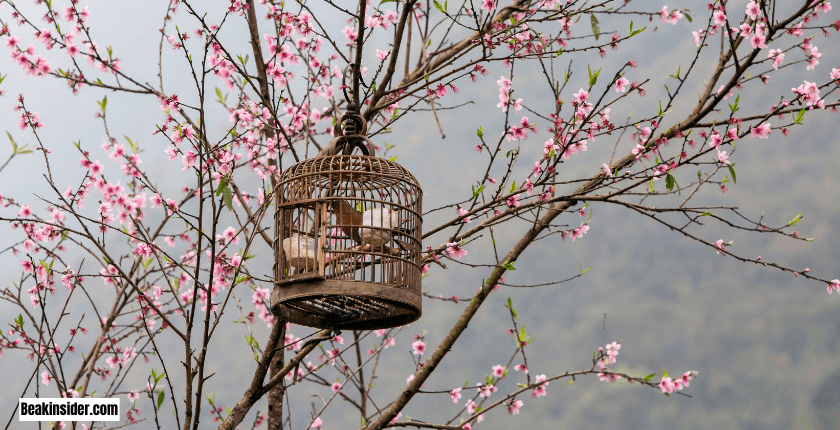Like other birds, parrots have unique sleeping styles and habits. It make them different from human beings. Captive parrot can sleep in different positions. These positions are sleeping on bars, standing on 1 leg and tucking their head under wings.
They are social birds that need a lot of time for rest and sleep to maintain their unique personalities. As a parrot owner, it is your responsibility to know the sleeping pattern and style of the parrots in the cage. Proper sleep is very important for parrots for their mental satisfaction.
In this article, I will tell you:
- How do parrots sleep in a cage?
- Factors that effect parrot sleep in a cage,
- Tips for helping your parrot to better sleep in a cage
- Frequently asked questions
Let’s start without wasting time!
How Do Parrots Sleep in a Cage?
Different parrot species have different sleeping behavior. The sleeping style of pet parrots differs from wild parrots. They sleep on branches of trees. In some cases, parrots like to sleep on bars and in some standing position, as they like.
Perching on One Leg
Many parrots like to sleep while standing on one leg. You must see parrots standing on one leg, when they sleep. They tuck one leg up to conserve their body energy and heat. This position is helpful for them to maintain balance. They feel secure while sleeping.
Tucking Their Head Under a Wing
Most parrots will tuck their head near their wings or back during sleep. Tucking of head is a sign that indicates your parrot feels safe. If parrots continue to sleep in this position, it means that they are comfortable.
Unihemispheric Sleep
Like wild parrots, pet parrots have unihemispheric sleep. It means that they can open one eye and one hemisphere of their brain while they sleep. This behavior is most common in wild birds as compared to pet birds. This behavior protects them from predators.
Quiet and Still
During sleep, they generally remain quiet and still. They adjust their position on the perch. But sleeping parrots are always peaceful, comfortable and relaxed.
Factors That Affect Parrots Sleep in a Cage

As a parrot owner you should know various factors that affect your parrots sleep in a cage.
Keep hovering!
Cage Size and Setup
Cage size and setup is very important for good sleep of parrots. A very small cage makes it hard for birds, especially parrots, to take rest. The ideal size of cake should be large with air ventilation. So, parrots stretch their wings and moves around.
- Perches: Parrots like to sleep at different heights. That’s why you should place different perches on different heights. Their tendency to mimic increases, when they sleep on tall branches.
- Comfortable Materials: The sleeping place of the parrot should be comfortable. It is preferable to use safe perches for parrot species. It prevents them from any discomfort and interruption.
Cage Location
The most important question is where to place the parrot’s cage for better sleep? As you know, parrots are sensitive to their surroundings. That’s why they need a dark and quiet area during their sleep time. For a quality sleep, you should provide an environment according to their preference.
- Avoid High-Traffic Areas: Never place the cage in the areas where there is a lot of noise. Avoid placing the cage near the drawing room, kitchen windows etc . It will disturb parrots and cause stress to them.
- Natural Light: It is better to place a parrot’s cage at the place where they follow a natural light cycle. It regulates their sleep time.
Cage Covers
Many parrot owners suggest using cage covers for better sleep of parrots. If you cover the cage, then it will create a dark and cozy environment. It makes the parrot happy and comfortable to sleep. Cover is important, as it reduces the noise level and extra light to reach the parrot.
- Using a Cage Cover: Make sure that the cover you use around the parrot’s cage is light-weighted and breakable. You should use the cover that locks the excessive light coming into the cage. But at the same time, it allows air ventilation.
- Benefits of Cage Cover: There are many benefits of covering the cage for parrots. Parrots feel secure, when you cover the cage.
Temperature Control
Temperature is the most important factor that affects your parrots sleep. As an owner, you should control the temperature of the room, where your parrot sleeps. Parrots like to sleep in the environment, where the temperature is not too high or not too cold. It is better to make the room cozy during night to ensure good sleep.
- Optimal Temperature: The ideal temperature of parrot room is 18 °C to 29 °C during sleep time. Extreme temperatures are difficult for parrots to sleep and rest.
Tips for Helping Your Parrot To Sleep Better in a Cage

As a parrot owner you should follow the mentioned tips for the better sleep of your parrot in the cage.
- Maintain a Consistent Sleep Schedule: Ensure that parrot follows a proper sleep schedule. They should have a proper routine of bed and waking up during the day.
- Limit Night Time Disturbances: It is most important to avoid disturbance near parrots. It includes excessive noise, lights or movements. These disturbances interrupt parrot’s sleep and cause stress and anxiety to them.
- Provide a Comfortable Perch: Make sure that your cutie pie has a comfortable place for rest and sleep. The sleeping place should have normal height, a smooth and stable position. So that parrots can sleep.
- Create a Dark Environment: Parrots prefer to sleep in a dark environment. For this purpose, it is better to cover the cage with a thin cloth that allow air ventilation.
Frequently Asked Questions (FAQs)
Do Birds Sleep In Nest?
No, birds don’t sleep in the nests. But they can only sleep when they have grown up. Nests are built for laying eggs, not for sleeping. Most birds sleep in sheltered spots. In includes tree branches, cavities and ground. But, it depends on the species. Some birds have the ability to sleep while flying.
Conclusion
It is important to know the sleeping behavior of parrots in cage to maintain their health and well being. Pet parrots have different sleeping habits then wild parrots. Like they have the style of sleeping on one leg, on the perch tucking their head covered with wings and many more. Parrots have the ability of unihemispheric sleep.
It means that they can sleep with one eye open. Proper sleep is better because your parrot cage setup is comfortable. It has no disturbance near the cage. Relax and peaceful environment will enable the parrot to stay happy and satisfied.
If you have any problem, text me in the comment box, I will reply to you soon. Thanks for reading!
Related Articles |
- Top Brightly Colored Pet Birds – 8 Beautiful Birds
- Reasons Why Owls Make Bad Pets? Hidden Facts
- Low-Maintenance Cost Pet Bird Species – 8 Pet Birds
- What Bird Has The Largest Beak? Hidden Facts
- Types of Parrots – 10 Affectionate Parrots

I’m Amna, and I absolutely adore birds, especially parrots. I’ve been immersed in the world of these colorful feathered friends for over 10 years. While I’m not a bird doctor, I’ve gathered a wealth of knowledge on how to care for and understand them.
My experiences extend to various bird species like parrots, macaws, cockatoos, canaries, and finches. In addition to my personal adventures with birds, I’ve dedicated time to volunteering at a local bird rehabilitation center.
My true passion lies in sharing what I know about parrots and birds with you. Through my articles, I aim to share the information you need to provide the very best care for your avian companions. So, let’s embark on this journey together and make your feathered friends’ lives as joyful and healthy as possible!

